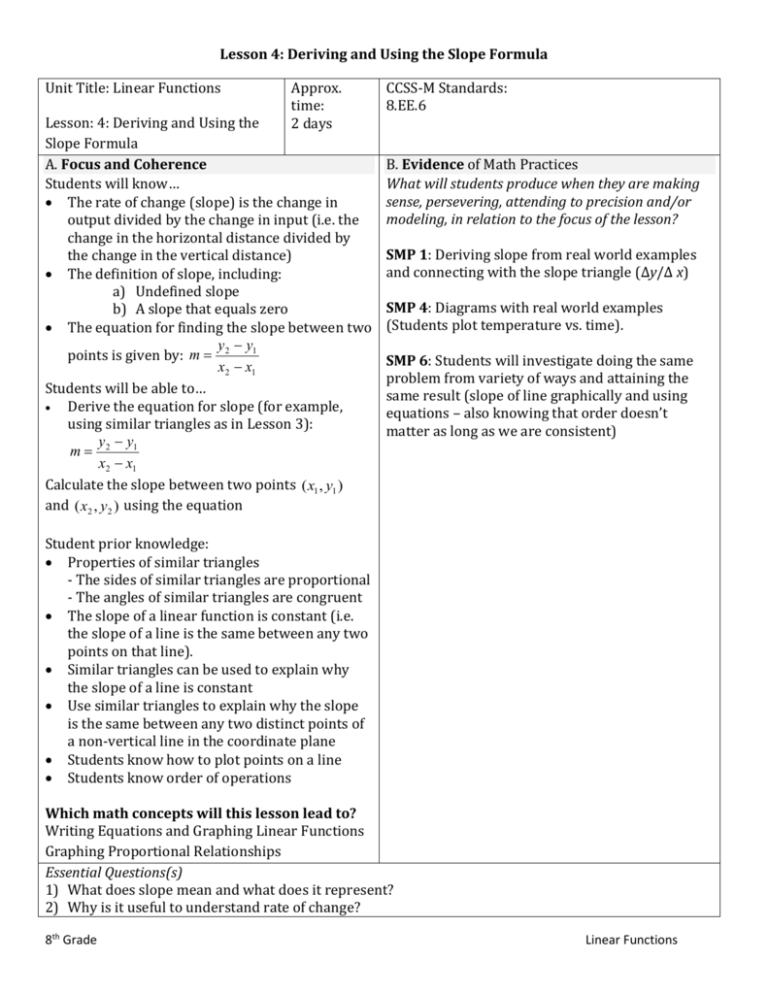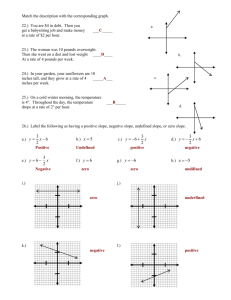8.Linear Functions Lesson 4
advertisement

Lesson 4: Deriving and Using the Slope Formula Unit Title: Linear Functions Approx. time: 2 days Lesson: 4: Deriving and Using the Slope Formula A. Focus and Coherence Students will know… The rate of change (slope) is the change in output divided by the change in input (i.e. the change in the horizontal distance divided by the change in the vertical distance) The definition of slope, including: a) Undefined slope b) A slope that equals zero The equation for finding the slope between two y y1 points is given by: m 2 x2 x1 Students will be able to… Derive the equation for slope (for example, using similar triangles as in Lesson 3): y y1 m 2 x2 x1 Calculate the slope between two points ( x1 , y1 ) and ( x2 , y2 ) using the equation CCSS-M Standards: 8.EE.6 B. Evidence of Math Practices What will students produce when they are making sense, persevering, attending to precision and/or modeling, in relation to the focus of the lesson? SMP 1: Deriving slope from real world examples and connecting with the slope triangle (Δy/Δ x) SMP 4: Diagrams with real world examples (Students plot temperature vs. time). SMP 6: Students will investigate doing the same problem from variety of ways and attaining the same result (slope of line graphically and using equations – also knowing that order doesn’t matter as long as we are consistent) Student prior knowledge: Properties of similar triangles - The sides of similar triangles are proportional - The angles of similar triangles are congruent The slope of a linear function is constant (i.e. the slope of a line is the same between any two points on that line). Similar triangles can be used to explain why the slope of a line is constant Use similar triangles to explain why the slope is the same between any two distinct points of a non-vertical line in the coordinate plane Students know how to plot points on a line Students know order of operations Which math concepts will this lesson lead to? Writing Equations and Graphing Linear Functions Graphing Proportional Relationships Essential Questions(s) 1) What does slope mean and what does it represent? 2) Why is it useful to understand rate of change? 8th Grade Linear Functions 3) When is it appropriate to use rate of change? Formative Assessments Anticipated Student Preconceptions/Misconceptions Picking one y and one x and using that instead of the difference in y and the difference in x 1 Sign changes (subtracting a negative #), Different ways to show negative fractions (ie: --2 = dividing by 0, remembering x is first, y is second, coordinate signs for quadrants −1 2 1 = −2 ), Materials/Resources Students need access to illustrations either magazines or internet. Rulers. Notebooks. Pencils. 8th Grade Linear Functions C. Rigor: fluency, deep understanding, application and dual intensity What are the learning experiences that provide for rigor? What are the learning experiences that provide for evidence of the Math Practices? (See Detailed Lesson Plan) Warm Up (Review & Preview) Day 1 2 Evaluate each expression below for a, when 𝑎 = 3, if possible. a. 24𝑎 b. 3𝑎 𝑎 c. 0 d. 0 𝑎 Find the distance between each pair of points graphically (using a ruler) a. (3, 7) and (8, 7) b. (-13, 7) and (8, 7) c. (0, 4) and (3, 7) d. (-2, 4) and (2, -3) Day 2 Solve each equation below for x. Check your solution. a. 3𝑥 − 7(4 + 2𝑥) = −𝑥 + 2 b. −5𝑥 + 2 − 𝑥 + 1 = 0 The figures below are similar (meaning they have the same shape). Use the information given about the lengths of the sides to solve for x and y. y 6 9 12 8th Grade 15 10 x 20 Linear Functions Lesson Day 1(Deriving Slope equation using similar triangles) Introduction: Let’s consider this function: x y 2 5 4 8 10 17 In graphing this function, is the function linear? How do we know? (S says: we know the function is linear because the rates of change remain the same between the points; graphically, the points form a straight line). Let’s consider the slope triangle made from the points by (2, 5) and (4, 8) and the slope triangle formed by the points (4, 8) and (10, 17). Is there anything we notice about the triangles? (S says: the triangles are similar) Is there anything similar about the side lengths within the triangles? Compare the vertical lines of each triangle and the horizontal lines of each triangle. Is there anything we notice about the side lengths? (S says the vertical sides lengths correspond to each other and the horizontal side lengths correspond to each other; they also represent the different between the x and y values of our coordinates) 𝑣𝑒𝑟𝑡𝑖𝑐𝑎𝑙 𝑙𝑒𝑛𝑔𝑡ℎ If we consider the ratio of ℎ𝑜𝑟𝑖𝑧𝑜𝑛𝑡𝑎𝑙 𝑙𝑒𝑛𝑔𝑡ℎ what does this give us? How do we find the vertical length? How do we find the horizontal length? 𝑣𝑒𝑟𝑡𝑖𝑐𝑎𝑙 𝑙𝑒𝑛𝑔𝑡ℎ ∆𝑦 𝑑𝑖𝑓𝑓𝑒𝑟𝑒𝑛𝑐𝑒 𝑖𝑛 𝑦 𝑦2 − 𝑦1 = = = = 𝑆𝑙𝑜𝑝𝑒(𝑚) ℎ𝑜𝑟𝑖𝑧𝑜𝑛𝑡𝑎𝑙 𝑙𝑒𝑛𝑔𝑡ℎ ∆𝑥 𝑑𝑖𝑓𝑓𝑒𝑟𝑒𝑛𝑐𝑒 𝑖𝑛 𝑥 𝑥2 − 𝑥1 Examples: Find the slope of the linear functions from the following problems (using similar triangles, graphically ∆𝑦 and finding ∆𝑥 ). a) 8th Grade Linear Functions b) x 0 3 12 y -2 4 22 c) (12, 5) and (4, -2) d) In an artic climate, three temperature readings were taken over a 5 hour span. The first reading read a temperature of -12°F. After two hours the temperature read -20°F and after 5 hours the temperature read-32°F. Create a graph that models the situation. Find the average temperature change over the 5 hour time interval. Day 2 (Calculating Slope Using Slope Formula) Remember our slope formula from yesterday? We defined slope as the ratio of vertical change (∆𝑦) to horizontal change (∆𝑥). 𝑣𝑒𝑟𝑡𝑖𝑐𝑎𝑙 𝑙𝑒𝑛𝑔𝑡ℎ ∆𝑦 𝑑𝑖𝑓𝑓𝑒𝑟𝑒𝑛𝑐𝑒 𝑖𝑛 𝑦 𝑦2 − 𝑦1 = = = = 𝑆𝑙𝑜𝑝𝑒(𝑚) ℎ𝑜𝑟𝑖𝑧𝑜𝑛𝑡𝑎𝑙 𝑙𝑒𝑛𝑔𝑡ℎ ∆𝑥 𝑑𝑖𝑓𝑓𝑒𝑟𝑒𝑛𝑐𝑒 𝑖𝑛 𝑥 𝑥2 − 𝑥1 Or simply, 𝑚= ∆𝑦 𝑦2 − 𝑦1 = ∆𝑥 𝑥2 − 𝑥1 What’s nice about this formula is that in addition to using similar triangle to find the slope of a line, we can now also use this formula to calculate for the slope of a line, remembering that the slope along a line is always the same. Let’s look at a case. 4.2.1 Michaela was trying to find the slope of the line shown below, so she selected two lattice points (locations where the grid lines intersect) and then drew a slope triangle. A ∆𝑦 B ∆𝑥 Her friend, Cynthia, wondered if instead of using the slope triangles to calculate the slope of line, could they find the slope using the coordinates of the points? (T models this to students as review) A. What are the coordinates of points A and B? 8th Grade Linear Functions B. What is the slope of the line using the side lengths of the triangle? C. What is the slope of the line using the slope formula? Today, we are going to use the slope formula as the way to determine the slope (knowing that if we graphed we would get the same information). T should show that it does not matter what Pt 1 and Pt2 are, as long as we are consistent. Let’s look at examples: A) (-2, 3) and (4, 5) 𝑚= ∆𝑦 ∆𝑥 = 𝑦2 −𝑦1 5−3 𝑥2 − 𝑥1 4− −2 2 1 = 6 simplified is 3 OR…. 𝑦2 −𝑦1 𝑥2 − 𝑥1 3−5 = −2−4 = 2 6 simplified is 1 3 you can see that as long as you are consistent with order, you end up with the same slope. Try both ways for the following point… B) (5, 6) and (3, 1) 𝑚= ∆𝑦 ∆𝑥 C) = 𝑦2 −𝑦1 𝑥2 − 𝑥1 1−6 −5 5 6−1 = 3− 5 = −2 = 2 OR…. 5−3 = −3 (4, -2) and (1, -5) Ans: −3 = 3 5 2 1 = simplified… 1! 3 1 Move onto examples of zero and undefined slope. What if the numerator was 0? What would that look like on a graph? Let’s talk about that… what does it mean? S answers … “y are the same” “there is not a change to the y” T asks students to plot points where the y is the same… (4, 5) (2, 5) (-1, 5) T: Using the slope formula determine the slope of the line. What is zero divided by a number? Ans: 0 T asks students to plot points where x is the same… (-2, 7) (-2, 4) (-2, -2) T: Using the slope formula determine the slope of the line. What is a number divided by 0? Can we do this? Why not??? Ans: Undefined – no slope Closure Let’s put this all together with a diagram… slope face… In your notebook let’s illustrate slope face… 8th Grade \ + | U 0 / - Linear Functions Suggested Homework/Independent Practice ∆𝑦 Day 1: Students identify slope from graph and slope from tabular data by finding ∆𝑥 . Day 2: Students independently find 3 illustrations of zero slope and3 illustrations of undefined slope. All examples should have calculations showing 0 and undefined slope. T shows diagram of window. S cannot use this as an example. 8th Grade Linear Functions




